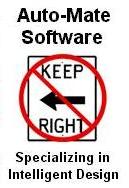|
|
||||||||||
 |
||||||||||
|
Why custom software? For that matter, why Auto-Mate Software? We’ll try to answer both of these questions on this page. |
|||
|
Many businesses struggle with trying to make their business fit within the constraints of an “off the shelf” software package. In time, it becomes obvious that one size does not fit all. Every business has its own special needs or quirks. How many systems don’t understand the concept of “cores” (if you’re in the automotive world) or deposits on containers? What if you like billing your customers twice a month or once every 2 months? How about a unique discount structure (click here to see one) or unusual inventory requirements (click here to see one) ? |
|||
|
There is no doubt that a business can get by with an off the shelf system for less initial outlay. If you look at the cost over a few years, the situation often changes. How, you ask? Several reasons: |
|||
|
|
Properly designed, written and supported custom software eliminates all of those problems. You get a system designed to precisely match the needs of your business both now and in the future, as well as increased employee productivity and decreased training time. |
|||||
|
You’ll notice the phrase “properly designed, written and supported”. As in every business, in the software world there are companies that provide shoddy products and/or services. How can you be sure you’ll get a quality product at a fair price? |
|||||
|
There are several things to go by: |
|||||
|
|||||
|
As mentioned on the home page, Auto-Mate Software has been in business since 1982. In the computer world, that makes us “old-timers”. Having been around that long, we have had a chance to work on many different types of systems for many different businesses. Please check the What We’ve Done page for some details. |
|||||
|
Auto-Mate Software believes in openness between its clients. Particularly if you are in the same business, we can all gain from talking to each other. However, if you prefer not to be involved in that way, we will happily respect your privacy. We will also share references with you, so you can learn about us directly from someone who has worked with us. |
|||||
|
When Auto-Mate Software puts together a system we focus on planning, design and the “user interface”. The basic structure and design are most important, but many systems, even though well designed behind the scenes, ignore the last, critical step. No matter how well the database and structure of a system is thought out, the greatest efficiency occurs “where the rubber meets the road”. In other words, if your employees aren’t happy and comfortable using a system, their work will suffer. |
|||||
|
The steps we normally use in building a system are as follows: |
|||||
|
|||||
|
What about support? Without it, you are dead in the water. We understand that and respond appropriately. During initial rollout of a system, you are likely to find us available 24/7. After things are running smoothly we are available during normal business hours, but able to respond to emergencies quickly. We want you to be happy with your system and will do everything possible to make sure of that. |
|
Source Code: In case you don’t know the term, source code is what the programmer writes to make the system. It then gets “translated” (“compiled”) into “machine code” which the computer can understand. Without the source code, no future changes can be made. |
|
Auto-Mate Software has always had a policy of ensuring that, should something happen, you will always be able to get the code to your system. Even if you choose to have one of our existing systems modified to fit your needs (and therefore have not paid for the source code), you will have access to a safe deposit box where a copy is kept. If you have paid for a full custom system, you will have current, up to date source code at your location at all times. |
|||
|
We work with several languages. For any custom work, we strongly recommend Visual DataFlex, as it is a very robust data aware programming environment that allows us to develop powerful applications quickly. Several of our current packages are written in VDF. If you don’t know it or would like to know more about it, visit www.datacccess.com for more information on this great tool. The latest “buzzword” in programming is “Object Oriented” and Microsoft is advertising it heavily. DataFlex has been object oriented for over 20 years and has a far better implementation of the concept than any other we’ve seen.. |
|||
|
We also work with Visual Basic because some companies require an “all Microsoft” solution. While using VB can leave a company more open to “hackers” and developing data-aware applications will take more time, many good programs (including some of ours) utilize it. |
|||
|
Databases are not language specific, except that the DataFlex database works best with Visual DataFlex. If you want MS Access or MS SQL Server, they can be used with either language. Unless you have large data needs, we like the DataFlex database as it provides great speed with very little disk space. It can also save thousands of dollars over MS SQL Server. |
|||
|
For reporting, in whichever language you choose, we normally use Crystal Reports. |
|||
|
Choosing custom software is not easy. It may even require a leap of faith! We will do everything possible to make sure you don’t regret that choice. |
|||
|
[Home] [Complete Systems] [Consulting Services] [Custom Software] [What We've Done] [What We'll Do] [Contact Us] |
|
|